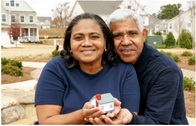Advertisement
Report Finds Credit-Impaired Minorities Have Limited Access to Mortgages

Access to mortgage refinance loans sharply declined in communities of color—and increased substantially in predominantly White neighborhoods, according to a report released by a multistate coalition of groups. The report, "Paying More for the American Dream V," examines changes in conventional refinance lending between 2008 and 2009 in seven metropolitan areas: Boston; Charlotte, N.C.; Chicago; Cleveland; Los Angeles; New York City; and Rochester, N.Y. It also compares 2009 loan denial rates across neighborhoods.
"Paying More for the American Dream V" was published by the the California Reinvestment Coalition, Community Reinvestment Association of North Carolina, Empire Justice Center, Massachusetts Affordable Housing Alliance, Neighborhood Economic Development Advocacy Project, Ohio Fair Lending Coalition and the Woodstock Institute.
In all seven cities analyzed, lenders denied loan applications at significantly higher rates in minority communities. In Charlotte, N.C., conventional refinance originations in predominantly White neighborhoods (under 10 percent minority) increased 105.5 percent from 2008 to 2009, when low interest rates gave borrowers an opportunity to significantly reduce their mortgage payments. In communities of color, it was a different story, in majority-minority neighborhoods the number of new refinance loans dropped by four percent. Borrowers had a much harder time getting loans. In predominantly-White areas, just 15 percent of conventional refinances loans were denied, compared to 37.4 percent in minority areas.
“Refinance loans are critical to stabilizing communities hardest hit by the foreclosure crisis,” said Sarah Ludwig, co-director of the Neighborhood Economic Development Advocacy Project (NEDAP) in New York. “Homeowners need access to sound loan modifications and refinance loans to lower their monthly mortgage payments and save their homes.”
The report finds that distinctions in access to credit are driven by differences in wealth. New underwriting standards impose greater expectations for borrowers to bring substantial downpayments to a lender, particularly for refinance. Many borrowers will not make a loan where the loan-to-value (LTV) ratio is greater than 70 percent. Given that the average white household has about 14 times more in assets than the average African-American household, the new requirements will shut the average African-American household out of the market for conventional loans.
“These findings build on our past reports, which have documented ongoing racial disparities in mortgage lending,” said Adam Rust, director of research at the Community Reinvestment Association of North Carolina. “Lenders are loosening up credit in predominantly White neighborhoods, while continuing to deprive communities of color of vital refinancing needed to aid in their economic recovery.”
The FDIC plans to require a down payment of twenty percent, under guidelines set out in the new Qualified Residential Mortgage (QRM) rules in the Dodd-Frank Act, for any loan delivered to the government-sponsored enterprises (GSEs). This means that the current underwriting standards implemented by private lenders will soon become standard expectations of the law.
Key findings in the report include:
►From 2008 to 2009 in the seven cities examined, applications for conventional refinance loans increased 76 percent in predominantly white neighborhoods, while the number of loans made in these neighborhoods increased 125 percent.
►Over this same period in communities of color, conventional refinance applications declined by 36 percent and originations declined by 17 percent.
►For example, in Chicago, conventional refinance originations in predominantly White neighborhoods increased by 102 percent from 2008 to 2009, but over the same period declined by 41 percent in communities of color.
►In the seven cities, lenders were more than twice as likely to deny conventional refinance loans to homeowners in communities of color as they were to homeowners in majority White neighborhoods in 2009.
►Denial rates in communities of color ranged from 28.9 percent in Los Angeles to 60 percent in Cleveland, whereas in predominantly White communities, denial rates ranged from a low of 11.7 percent in Boston to a high of 24.4 percent in New York.
The multistate coalition details a series of policy recommendations in the report. The groups specifically call on regulatory and enforcement agencies to:
►Ensure access to affordable mortgage credit, ncluding 30-year fixed-rate mortgages, as new regulations and housing finance reforms are implemented;
►Reach a strong State Attorneys General settlement with mortgage servicers, to curb fraudulent foreclosure practices and hold servicers accountable.
►Require public disclosure of detailed mortgage lending and loan modification data, to create transparency around bank lending and foreclosure practices.
►Expand the Community Reinvestment Act (CRA) to promote responsible lending and
investment.
About the author





